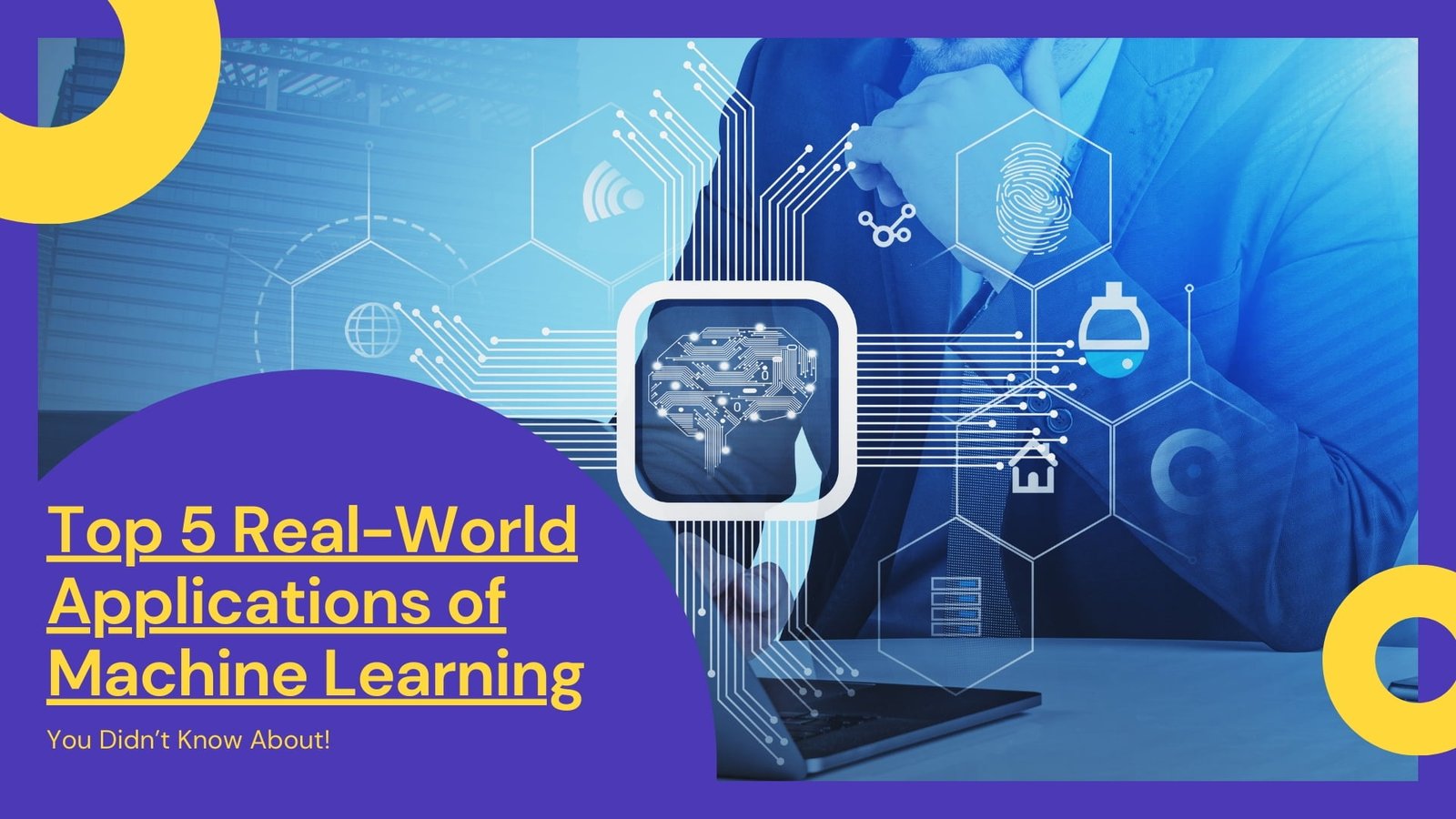It has developed from a niche idea into the driving force behind some of the most innovative and practical solutions in diverse sectors. While many may recognize its application in recommendation systems or self-driving cars, several other uses of ML are making deep impacts that often go unnoticed. In this article, we’re going to dig deep about five lesser-known yet powerful applications of machine learning that are changing industries and daily lives.
1. Machine Learning in Environmental Conservation

Trying to stop the planet without the input from machine learning, which now has the great impact in environmental conservation work, will not work. Using satellite image, sensors, and historical climate information, the ML (machine learning) algorithm can show the prediction and evolution of the ecosystems with very high accuracy. Predictive power is of great importance in forest management, wildlife conservation, and prevention of illegal poaching.
Predicting Deforestation with Machine Learning
Among the most important problems in environmental conservation is deforestation prediction and prevention. Traditional approaches usually carry out manual surveys and wait until satellite data is analyzed, resulting in a reactive rather than a preventative response. Machine learning models, however, can analyze vast datasets from multiple sources in real time, identifying patterns that indicate potential deforestation. These models are used to detect initial deforestation signature, including vegetation cover change, soil moisture change, and so, in details low land use change patterns. With the ability to predict deforestation hot spots, conservationists can take preventative measures, for example, sending rangers into high-risk areas or partnering with local communities to adopt sustainable land use strategies.
Wildlife Poaching
Another area where machine learning is making strides is in combating wildlife poaching. Illegal poaching continues to threaten endangered species globally. These algorithms are now employed in the analysis of data from camera traps, drones and even the social media that surrounds poacher activity, all of which can be used to predict where poaching is most likely to take place. For example, a model can analyze the images taken by camera traps in real-time by the camera, not only as what kind of animal has been caught, but also as suspicious human encroachment into protected areas. This information is then analyzed and compared with weather trends, among other parameters, to foresee an incident of poaching which they would be able to intervene in advance before it were too late.
Improving Conservation Approaches
In environmental conservation, machine learning activities have the added value of improving conservation strategy. By using analysis of historical data on wildlife population, migration, and habitat variability, machine learning models can be designed to simulate the response of species to various types of conservation interventions. Using this predictive ability, conservationists are now able to better design their strategies in a way that resource allocation will maximize impact where they have the greatest effect. For example machine learning could be used to give an indication of where to best place wildlife corridors, or when to deploy anti-poaching patrols to best effect.
2. Machine Learning in Healthcare Diagnostics

Technology innovation has always been in a prime target for the healthcare sector, and now at center of the disruption of diagnostics, it is machine learning. Thanks to ML algorithms, the medical data its presented and huge amounts of data can be mined, by doctors, better diagnoses, estimate of patient outcome and even uncovering of new treatment approaches are possible.
Early Disease Detection
Perhaps the most exciting potential use of machine learning for healthcare is its application for early disease diagnosis. E.g, ML algorithms have already been implemented to process medical images -e.g., X-ray and MRI-detecting diseases such as cancer at its earliest stage as compared with previously known by conventional methods. Having been trained on tens of thousands of images, they develop the ability to detect patterns that can help us to diagnose a disease, often before the disease is otherwise visible with the human eye. Early diagnosis goes hand in hand with better prognosis, but the price tag of treatment is also reduced, since the problems are confronted at a relatively early stage of progression.
Personalized Treatment Plans
One of the applications of machine learning in health care is designing individualised treatment plans. Traditional therapies are a “one cure for one person” model, which does not work for certain persons. Machine learning models can read the patient’s genetic, lifestyle, and medical history to estimate the treatment response to each of them. The individualized treatment approach guarantees patients the most effective treatments for their individual diagnosis, minimizes the risk of treatment complications, and increases the overall treatment outcome rate.
Predictive Analytics for Patient Outcomes
Predictive outcome for patients is one key application of machine learning that holds great promise in critical care. In particular, machine learning algorithms applied to electronic health record data can prospectively predict postoperative risk for patients at increased risk of complications, e.g., infection or postoperative readmissions. Prognoses realised enable practitioners to take early action, and thus improve patient results and decrease hospital expenditures. For instance, a machine learning algorithm might predict the probability of a post-operative infection based on a patient’s vital signs, lab results, and medical history so doctors could intervene long before symptoms became apparent.
Must Read: How to Choose the Best Machine Learning Framework for Your Needs?
3. Machine Learning in Financial Fraud Detection

There is nothing more unequal for financial institutions than their capacities to become familiar and adapt with new technologies to ensure the protection of their assets and their customers. Long anticipated, Machine learning has at last cracked the code in the effort to win against financial fraud. By analyzing huge amounts of transaction data, ML algorithms are able to identify accurately what has otherwise been deemed fraudulent transaction data, thereby minimizing the risk of infringing upon financial loss and consumer trust.
Real-time Fraud Detection
That machine learning may analyze transactions in real-time is, without a doubt, one of the most critical benefits of applying this technique to financial fraud detection. Many fraud detection approaches are based on previously set rules and thresholds that lead to false detecting and fraudulent activities being missed. But a machine learning based model would be capable of learning the patterns and anomalies present in the huge amount of historical data, which could attribute to the fraud. For instance, a model of machine learning could analyze patterns of credit card transactions in terms of frequency and location, flagging any transactions as possibly fraudulent which are out of the ordinary for the transactions of the cardholder. Real-time analysis allows fraud detection to flag and block such transactions before they are completed, avoiding losses and protecting customers.
Adaptive Learning in Fraud Detection
The ability of ML in the fraud detection domain to learn from emerging threats is yet another important feature of ML. With fraudsters becoming better at it, indicators in traditional rule-based systems cannot be kept up to date. Machine learning models, however, not only learn from novel data but also relearn by updating their algorithms to identify a new stream of fraud patterns. It is through this adaptive learning ability that financial institutions remain ever one step ahead of the fraudsters, preventing the emergence of new victimised fraud, even before they become widely circulating.
Minimizing False Positives
Rising security needs will always come with a trade-off to customer experience. False positives, good transactions mistakenly identified as fraud, can annoy customers and potentially lose businesses. Machine learning models can do the best job of reducing false positives by using more granular data to spot more subtle behavioral patterns. For instance, a machine learning model can take into consideration a set of events, such as the time of day, the type of merchant, and the recent spending history of the customer. This results in higher fraud detection accuracy and reduced false positives.
4. Machine Learning in Supply Chain Optimization

Any business will look like a feeble spine without an efficient supply chain. Supply chains are made as efficient as possible and cost savings and efficiency enhancements can be quite large. Today, machine learning is being used to enable supply chains to be automated, demand to be predicted, and stock to be managed with unprecedented precision.
Demand Forecasting with Machine Learning
In all the dimensions of supply chain management, most critical from all those is demand forecasting. The accurate forecasting of demand can be used for any company to control the inventory costs, minimise the losses and satisfy the customers demand. Conventional techniques for demand forecasting typically rely on historical sales data and trivial statistical models that may not reflect current market behaviour. Comparatively, ML models are much better than conventional techniques at able to machine interactively with almost unlimited data-historical sales information, market trends, social media sentiment, etc.-in order to forecast future demand more precisely. For instance, a model that is based on machine learning may study the trajectory of a social media blitz in order to adjust product supply in response to the level of demand for that product.
Inventory Optimization
Machine learning is also used to enhance inventories to the greatest extent possible, e.g., inventory management. Businesses would guarantee the availability in the right amount at the right times of the right product. Inventory management are commonly adjusted manually in the conventional inventory management, and such methods are likely to lead to overstocking or sometimes stockout situations with negative economic consequences. Machine learning-type models can learn from past sales information, supplier delivery lead times, and the rest of the relevant information to predict what inventory holding levels to maintain. For example, such a machine learning algorithm would estimate that a particular product will experience a surge in demand just before a relevant holiday; and at such time, the concern can be adequately resupply with the products.
Improving Relationships with Suppliers
Machine learning is also contributing to better working relationships with suppliers. Data analysis of supplier performance, delivery schedules and quality can enable enterprises to select the best suppliers from the available market and then negotiate more favorable contracts. In any event, with machine learning, for example, it can be useful to analyze past data on the supply of goods in order to forecast which suppliers will, in fact, deliver goods on time, so that they can be placed at the top of the waiting list to ensure that the delivery schedules are respected. This predictive power can result in the development of a more powerful supplier relationship and a more efficient supply chain operation.
5. Machine Learning in Personalized Education

The education sector is another important area where machine learning has a great influence, especially in the topic of personalized learning. Machine learning models are helping educators tailor teaching methods to individual students through various data analyses concerning student performance, learning styles, and engagement.
Adaptive Learning Platforms
The greatest application of machine learning in education is probably the development of adaptive learning platforms. Such platforms use algorithms based on machine learning to analyze data on student performance in actual time and adjust the learning experience. For instance, if a student
If a student is found to be struggling with a specific topic, the system may supplement with extra materials, like video tutorials or quizzes, to aid understanding. On the other hand, if a student is performing well, the system may supply challenging content to continue to engage the student. In this way, every learner will get the support needed for success, potentially making it easier to ensure good educational outcomes.
Predictive Analytics for Student Success
In addition, it has even been used in the forecasting of the success probability of students such that if a student is about to fall behind or be a failure, an educator may, based on machine learning, intervene early. Machine learning models could identify patterns in data regarding student attendance, participation, and grades in this regard. For instance, a machine learning model might predict that a student is at risk of failing a course, having conducted an analysis of performance in previous assignments; the educator then helps such students before time gets away.
This ability can reduce the dropout rate and increase the probability of more achieving their goals through education.
Improving Student Engagement
Machine learning is also impacting another area: enhancing student engagement. It is possible to find the types of content that most keep students engaged through the analysis of data showing interaction of the students with learning materials. For instance, one machine learning model may study information on how different types of multimedia, for example videos, interactive simulations, or text-based content, affect students’ interactions and provide recommendations on the most engaging materials for each student. This personalized approach ensures that students remain motivated and interested in their studies, leading to better learning outcomes.
Must Read: The Ethical Considerations of Machine Learning: What Are the Challenges?
Frequently Asked Questions
What are some lesser-known applications of machine learning?
Machine learning is used in various lesser-known areas such as environmental conservation, healthcare diagnostics, financial fraud detection, supply chain optimization, and personalized education.
How does machine learning help in environmental conservation?
Machine learning helps predict deforestation, combat wildlife poaching, and optimize conservation strategies by analyzing data from satellite imagery, sensors, and historical climate data.
Can machine learning improve healthcare diagnostics?
Yes, machine learning enhances healthcare diagnostics by enabling early detection of diseases, creating personalized treatment plans, and predicting patient outcomes.
What role does machine learning play in financial fraud detection?
Machine learning detects financial fraud by analyzing transaction data in real-time, adapting to new threats, and reducing false positives.
How is machine learning used in supply chain optimization?
Machine learning optimizes supply chains by improving demand forecasting, inventory management, and supplier relationships.
What is the impact of machine learning on education?
Machine learning personalizes education through adaptive learning platforms, predictive analytics for student success, and enhanced student engagement.

